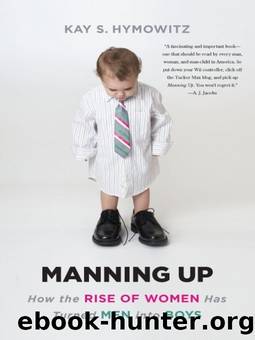Manning Up: How the Rise of Women Has Turned Men into Boys by Kay S. Hymowitz

Author:Kay S. Hymowitz [Hymowitz, Kay S.]
Language: eng
Format: mobi
ISBN: 9780465031405
Publisher: Basic Books
Published: 2012-03-05T16:00:00+00:00
That sound you hear? That’s women not laughing. Oh, some of them get a kick out of child-men and their frat/fart jokes; Maxim has claimed that more than 20 percent of its readers are female,18 for instance, and it’s reasonable to suppose that not all of them are doing R&D for the dating scene. But many members of the New Girl Order, understandably put off by Juggies and exploding toilets, blame the media for the child-man in their midst.19 They’re right to this extent: pop culture is more than occasional entertainment for this population. It is the oxygen they breathe. In About a Boy, Nick Hornby—a British novelist and one of the shrewdest child-man observers—writes about his 36-year-old slacker hero: “Sixty years ago, all the things Will relied on to get him through the day simply didn’t exist: there was no daytime TV, there were no videos, there were no glossy magazines . . . and there were probably no record shops. . . . Now, though, it was easy [to not work]. There was almost too much to do.”20 Will, whose name is a joke because he has so little of it, has no self apart from pop culture effluvia, a fact the author symbolizes by having him live off the residuals of a popular Christmas song written by his late father.
Still, blaming the media doesn’t make much sense. Media execs just want to find an audience; they make dumb Adam Sandler movies and Super Bowl ads because that’s how they can lock those eyeballs. They can’t foist a new cultural type on an unwilling public. Media executives didn’t invent the child-man; they uncovered him. So the question is: how did the child-man get inside the contemporary SYM?
The most prevalent theory comes from feminist-influenced academics and cultural critics. In a series of books and articles published in the 1990s, these writers argued that men were suffering a “crisis of masculinity” taking the form of a defensive backlash against feminist gains. Threatened by women’s empowerment and in an age of downsizing, manufacturing decline, and the erosion of the living wage, men were “cling[ing] desperately to outdated roles,” in the words of prominent theorist Susan Faludi in her 1991 book titled, simply, Backlash. Faludi followed up with Stiffed in 1999, in many respects a more sympathetic treatment of men, but one that nevertheless posited that they grow up believing they are “going to be the master of the universe and all that was in it.”21 Their disappointment with their downsized fate, she concludes, drives them to macho displays.
In his 2008 Guyland: The Perilous World Where Boys Become Men, the gender studies sociologist Michael Kimmel applied Faludi’s reading of the masculinity crisis specifically to young men. In Kimmel’s view, today’s young men have “a privileged sense that they are special, that the world is there for them to take.” To maintain their status among the entitled, they follow the “Guy Code,” a set of behaviors that include “never showing emotions or admitting to weakness,” ridiculing homosexuals, and trying to “have sex with as many women as possible.
Download
This site does not store any files on its server. We only index and link to content provided by other sites. Please contact the content providers to delete copyright contents if any and email us, we'll remove relevant links or contents immediately.
Rewire Your Anxious Brain by Catherine M. Pittman(18555)
Talking to Strangers by Malcolm Gladwell(13235)
The Art of Thinking Clearly by Rolf Dobelli(10234)
Mindhunter: Inside the FBI's Elite Serial Crime Unit by John E. Douglas & Mark Olshaker(9214)
Becoming Supernatural by Dr. Joe Dispenza(8127)
Change Your Questions, Change Your Life by Marilee Adams(7641)
Nudge - Improving Decisions about Health, Wealth, and Happiness by Thaler Sunstein(7622)
The Road Less Traveled by M. Scott Peck(7525)
The Lost Art of Listening by Michael P. Nichols(7412)
Enlightenment Now: The Case for Reason, Science, Humanism, and Progress by Steven Pinker(7243)
Mastermind: How to Think Like Sherlock Holmes by Maria Konnikova(7234)
Win Bigly by Scott Adams(7097)
The Way of Zen by Alan W. Watts(6513)
Daring Greatly by Brene Brown(6451)
Big Magic: Creative Living Beyond Fear by Elizabeth Gilbert(5618)
Grit by Angela Duckworth(5525)
Ego Is the Enemy by Ryan Holiday(5298)
Men In Love by Nancy Friday(5162)
Altered Sensations by David Pantalony(5048)
